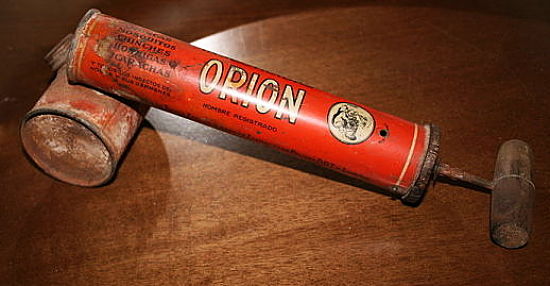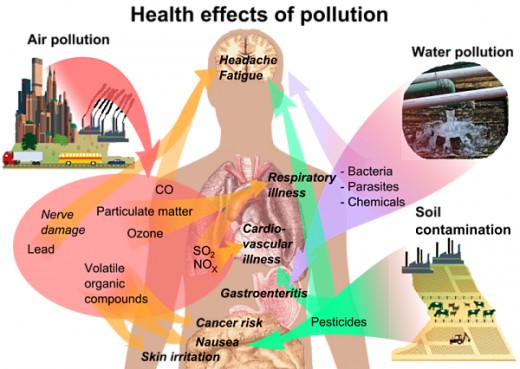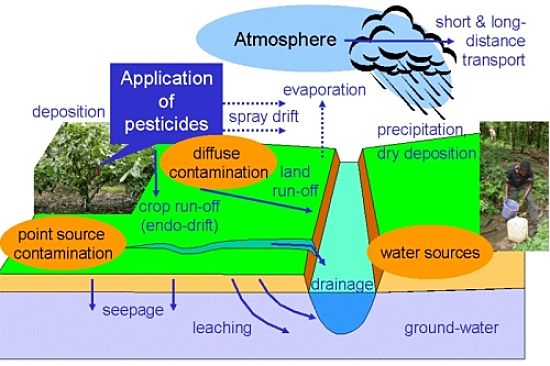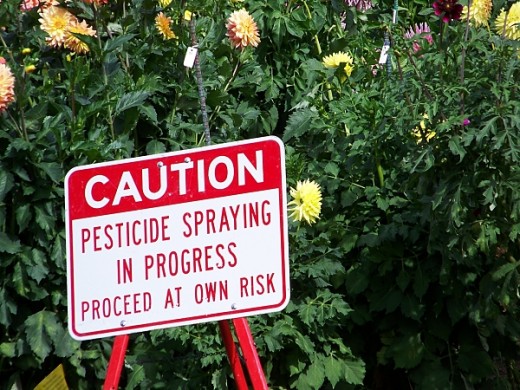How to Reduce Exposure to Common Pesticides in Food and at Home
Many people have developed lackadaisical attitudes to pesticides that are applied during the growing of fruit and vegetable crops. This means that pesticides remain as residues on the surface of foods and as internal contaminants in most food that we buy in stores. The exception is organic food which is hopefully free of pesticides.
Exposure to pesticides can happen in the workplace, through spray drift, through contaminants on foods, and through use of pesticides in the garden or home.
Modern pest control devices are designed to spray streams of insecticides into the air at set time intervals more or less continuously. Have you every worried about the consequences of living in an environment with insecticide constantly hovering in the air?
Various spray bombs for controlling cockroaches and other insects leave residues throughout the house. Many advertisements claim this bomb in the atmosphere as a benefit for the product.
Have you every worried about the hidden dangers of long term pesticide exposure in your house?
How safe are these pesticides? What are the side-effects?
How can you reduce the risks and minimize exposure to pesticide contaminants?
This article highlights the risks and discusses the steps you can take to reduce contamination at work and at home.




Pesticides are used to protect plants and animals against molds, fungi, insects and rodents. They are very important to maintain crop yields, prevent crop losses, stop plant produce being spoiled by insect marks and invasions and also prevent human diseases associated with pests. There are almost 1000 pesticides registered for use worldwide.
What are the Potential Harmful Effects of Pesticides?
Pesticides have been shown to have a wide range of acute and chronic toxicity in animals and humans. There is an alarming amount of research linking pesticides with a range of chronic health impacts on children, including behavioral problems, such as ADHD, brain development, asthma, birth defects and cancer. Exposures before birth, household and food related exposure and exposures related to the parents employment. Various health authorities have advised that pregnant women and children should be protected by limiting pesticide intakes should be limited as much as possible.
The food supply is the most important source of exposure for organochlorines and other pesticides. Various health authorities throughout the world set ‘tolerances’ for foods, which are the maximum pesticide levels that can legally be found on, or in, food. Recent surveys have shown that 29% of vegetables, 49% of fruit, 26% of grain products and 24% of fish/shellfish had detectable, but legally permitted pesticide residues. Some vegetables and fruit are regularly found with residues above legal tolerances, generally about 2%, but up to 10% of imported fruit and vegetables.
Consumption of organic food has been shown to reduce pesticide exposure. Studies of children who ate an organic diet for five days shown a rapid and substantial drop in their urinary excretion of malathion and chlorpyrifos OP insecticides.
Pesticides are stored in your colon and in fat tissue and can they slowly have cumulative effects on the body. Ironically the push by health authorities for adults and children to eat more fruits and vegetables may be increasing the loads of pesticides they are consuming. Eating an apple can mean ingesting over 30 different pesticides that have been sprayed on the apple during its growth and packaging. Even if you wash an apple, some pesticides may remain or could have been absorbed into apples and other fruit or vegetables. Soft-skinned fruits and vegetables that are harvested just before sale are very vulnerable to insect attack and are sprayed frequently with insecticides. This includes foods such as spinach, grapes, apples, tomatoes, strawberries, berries and cucumbers are just a few types of food (especially imported foods) that you should not eat if you have any doubt about the source or they are not certified as organic. People should be especially vary of fruit from local markets that is not organic, because pesticide use may be less well regulated. Similarly imported seafood, especially farmed fish and prawns may be seriously contaminated with pesticides, and any bacteria may be resistant to antibiotics that are widely used in the aquaculture industry.
Reducing the Risk of Pesticide Contaminated Food
Apart from organic produce, you should expect that most fruit and vegetables have been sprayed with insecticide, especially the soft and perishable ones such as tomatoes, plums, peaches, apricots and apples. Any food item such as oranges that are peeled before being eaten should be OK, but the skin may still have pesticide on it, which can get on your hands.
To help reduce the risk of pesticide contamination, thoroughly wash all fruit and vegetables. Any fruit or vegetable with a soft skin is a potential risk as the pesticide may have penetrated into the skin and cannot be washed off. Always try to peel hard-skinned fruits and vegetables, or rinse it well with plenty of warm water to which salt and a little vinegar or lemon juice has been added. Also it is a good idea to remove the outer leaves of leafy vegetables and then rinse them well with tap water. Organic growers do not use synthetic pesticides on their fruits and vegetables, but they may use natural ones. It always pays to wash and peel all organic produce as well as there are various sources of contamination, especially if the retail outlet sells organic and non-organic produce.
Best and Worst Fruits and Vegetables for Pesticides in USA
|
Category
|
Food
|
|---|---|
|
Worst Fruit
|
Apples
|
|
Peaches
|
|
|
Strawberries
|
|
|
Nectarines
|
|
|
Grapes
|
|
|
Blueberries
|
|
|
Worst Vegetables
|
Spinach
|
|
Lettuce
|
|
|
Cucumbers
|
|
|
Celery
|
|
|
Sweet bell peppers
|
|
|
Potatoes
|
|
|
Green beans
|
|
|
Kale/Greens
|
|
|
Best Fruit
|
Pineapples
|
|
Mangoes
|
|
|
Kiwi Fruit
|
|
|
Cantaloupe
|
|
|
Grapefruit
|
|
|
Watermelon
|
|
|
Best Vegetables
|
Onions
|
|
Sweet Corn
|
|
|
Avocado
|
|
|
Sweet peas
|
|
|
Asparagus
|
|
|
Eggplant
|
|
|
Sweet potatoes
|
|
|
Mushrooms
|
The Best and Worst Fruits and Vegetables for Pesticide Contamination
European Pesticide data and that for America (EWG), are shown in the table to the side and below.
A summary list of the best and worst fruits and vegetables have been prepared, that are shown below
Worst Fruit for Pesticides - Buy Organic
The worst fruit for pesticides and the soft skinned varieties that are pick when almost ripe, when they are most vulnerable to insect attack
- Apples
- Peaches
- Pears
- Strawberries
- Nectarines
- Peaches
- Grapes
- Apricots
Best Fruit Low in Pesticides
The best fruit are those with thick skins like mangoes, bananas, grapefruit and melons. The skins are removed and discarded eliminating any surface contamination.
- Pineapples
- Mangoes
- Kiwi Fruit
- Banana
- Cantaloupe
- Grapefruit
- Watermelon
- Melons
Worst Vegetables for Pesticides - Buy Organic
Like the worst fruit, the worst vegetables for pesticides and the soft skinned varieties such as tomatoes and green leafy vegetables
- Tomatoes
- Parsnips
- Cucumber
- Carrots
- Lettuce
- Beans in a pod
- Peas in a pod
- Spinach
- Lettuce
- Cucumbers
- Celery
- Sweet bell peppers
- Green beans
- Kale/Greens
Best Vegetables for Pesticides
The best vegetables are those protected by skins that are removed before being used such as onions, avocado and sweet corn.
- Onions
- Sweet Corn
- Avocado
- Sweet peas
- Asparagus
- Eggplant (Aubergines)
- Sweet potatoes
- Mushrooms
- Leeks
- Chilli
- Potatoes
Best and Worst Fruits and Vegetables in Europe
|
Food
|
Percent of Sample containing residues
|
Percent of Residues that exceed Standards
|
Percent of Samples Containing Multiple Residues
|
|
|---|---|---|---|---|
|
Worst Fruits
|
Soft Citrus
|
100
|
0
|
100
|
|
Pineapples
|
94
|
0
|
10.4
|
|
|
Pears
|
90
|
1.4
|
81
|
|
|
Apples
|
89
|
1.4
|
76
|
|
|
Grapes
|
88
|
2
|
70
|
|
|
Strawberries
|
86
|
0
|
71
|
|
|
Peaches and Nectarines
|
83
|
3
|
49
|
|
|
Apricots
|
78
|
0
|
52
|
|
|
Worst Vegetables
|
Tomatoes
|
81
|
2.1
|
52
|
|
Parsnips
|
77
|
0
|
67
|
|
|
Cucumber
|
64
|
1
|
36
|
|
|
Carrots
|
63
|
0
|
32
|
|
|
Lettuce
|
59
|
0
|
27
|
|
|
Beans in a pod
|
58
|
14
|
39
|
|
|
Peas in a pod
|
57
|
4.1
|
37
|
|
|
Sweet Potatoes
|
57
|
0
|
6.4
|
|
|
Courgettes and Marrows
|
48
|
0
|
13
|
|
|
Yams
|
48
|
22
|
28
|
|
|
Best Fruits
|
Star Fruit
|
17
|
10
|
0
|
|
Plum
|
23
|
1.4
|
5.6
|
|
|
Exotic Fruits
|
34
|
15
|
14
|
|
|
Kiwi Fruit
|
44
|
1
|
4.2
|
|
|
Banana
|
57
|
0
|
38
|
|
|
Raspberries
|
58
|
0
|
42
|
|
|
Other Berries
|
69
|
0
|
61
|
|
|
Melons
|
75
|
3.1
|
41
|
|
|
Best Vegetables
|
Corn (cob)
|
0
|
0
|
0
|
|
Leeks
|
8
|
1.4
|
4.2
|
|
|
Aubergines
|
20
|
5.7
|
5.7
|
|
|
Onions
|
29
|
0
|
2
|
|
|
Ginger
|
33
|
0
|
0
|
|
|
Chilli
|
9
|
6.5
|
22
|
|
|
Potatoes
|
44
|
1
|
8.3
|
|
|
Peppers
|
45
|
0
|
34
|
|
|
Celery
|
46
|
0
|
12.5
|
|
|
Spinach
|
47
|
2.5
|
22
|
|
|
Worst Other foods
|
Oily fish
|
67-98
|
10
|
0
|
|
Cereal grains
|
79-91
|
1.4
|
5.6
|
|
|
Flour
|
73
|
15
|
14
|
|
|
Cereal bars
|
68
|
1
|
4.2
|
|
|
Dried fruit
|
58
|
0
|
38
|
|
|
Bread
|
33-56
|
0
|
42
|
|
|
Herbs
|
53
|
|||
|
Chips
|
8
|
0
|
61
|
|
|
Crisps
|
45
|
3.1
|
41
|
|
|
Rice
|
45
|
Precautions When Using Pesticides at Home
- Don't place bait, set traps or use insecticide ‘bombs’ in areas where pets or children have access
- Keep pesticides in the original container, so that it does not get confused with something else. Keep the lid firmly secured, well out of the reach of children and with the label and advice always available
- Don't drink, eat or smoke while using pesticides and always wear gloves and masks
- Don't stock up on pesticides and only purchase the quantity you need – reduces the risk of poisoning and inappropriate use.
- Always read and follow the manufacturer's instructions and don’t be tempted to double the strenth
- Don't mix different pesticides together
- Always wear protective clothing and rubber gloves and wash thoroughly after use
Precautions When Using Pesticides Indoors
- Don't spray pesticide onto areas or items such as furniture or toys that are touched by family members.
- Always exit from any room while any sprayed pesticide, or ‘roach bombs’ are working and cover any cooking utensils to prevent contamination. Open the windows to clear the air before you return
- Remove or cover any food or personal items from the area being treated. Always clean kitchen surfaces and food preparation boards and benches well before preparing food
- Precautions When Using Pesticides Outdoors
- Close all windows and doors before spraying pesticide
- Cover barbecues, fish ponds, outdoor furniture and vegetables in gardens,
- Relocate pets and their bedding before spraying pesticides
- Don't spray pesticides outdoors when its windy or raining
- Inform your neighbors if you intend to use any outdoor pesticides than may affect them through spray drift.
How to Reduce the Need to Use Pesticides around Your Home and Yard
- Don't place piles of wood chips or mulch near the house that encourages insects
- Drain any puddles of water and water containers such as pots and buckets, as soon as possible.
- Seal cracks and crevices where cockroaches and other insects may get access to the house
- Keep outdoor compost containers and rubbish bins well sealed
- Keep gutters and drains free of leaves and debris to prevent puddles of water
- Parents who handle pesticides should wash careful and remove gloves and contaminated clothing before entering the house.
- Throw out any pet food remnants quickly and dispose of any fruit fallen from fruit trees